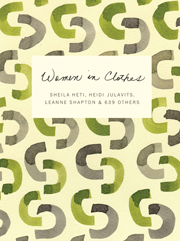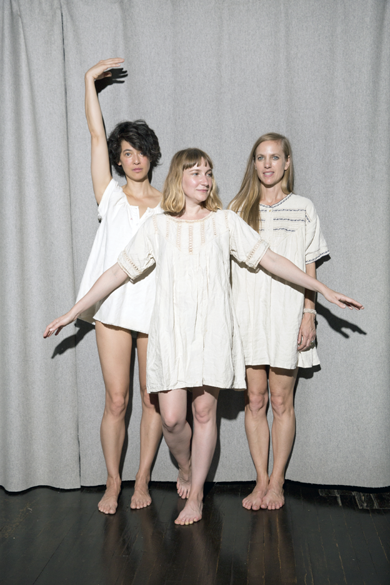Sheila Heti, Heidi Julavits, and Leanne Shapton on Women in Clothes
Sheila Heti, Heidi Julavits, and Leanne Shapton discuss how the clothes we wear shape our lives
Women and clothes are literally and conceptually together everywhere—in the streets, in magazines, on bus shelters and billboards. But what do ordinary women think about when they get dressed? Sheila Heti, Heidi Julavits, and Leanne Shapton, the editors of Women in Clothes, out this month from Blue Rider Press, decided to find out by surveying women they knew about clothes. They asked women eighty-three questions, which included: “Is there a certain look you feel you are expected to like that you have absolutely no interest in?” “When you see yourself in photographs, what do you think?” “How do you conform to or rebel against the dress expectations at your workplace?” The women they surveyed were also encouraged to engage in various creative and critical projects to explore their relationships to clothing. The result is a volume that combines the voices of 642 women—artists, dog catchers, office workers, farmers, writers, pilots, and everyone in between, stitching together survey answers, personal essays, poetry, photography, and illustration. The book is also peppered with short transcripts of women’s complements to other women and the brief conversations and connections that emerge from saying “I like that lipstick,” or “nice dress,” or “that’s a great haircut.” I talked to the editors about their ambitious and original project.
1. Sheila, were you the one who first had the idea of doing something like this? Did you envision it originally as a book?
Sheila Heti: I was looking for a book that would tell me what women thought about as they got dressed, how they put their style together and what the meanings were for them in dressing. It wasn’t an area of my life that I had given that much thought to. I literally went to a store to look and there was no such book. I thought, I’ll just do a little survey of my own, and I wrote an email to a group of female friends. I asked the kind of questions that I wanted to have answered. Heidi was the one who was like “I think this could be a book, maybe we could work on this as a project together.” I felt a little bit embarrassed about sending those questions around but the fact that Heidi responded so enthusiastically made me feel like maybe it was not just me who would be interested, maybe a book would be a good idea, and maybe it wasn’t embarrassing to ask other people these questions.
Heidi Julavits: No one had ever asked me questions like the ones Sheila asked. I just couldn’t stop writing answers to them, it felt so liberating. They enabled me to talk about memories I had, beliefs I had, all of these unarticulated systems that I had in place for myself.
SH: The last book I published, Leanne did the cover. For me, the cover of that book gave the book so much of its character. I thought that if Leanne would also agree to do this it would be the perfect chemistry or perfect alchemy.
Leanne Shapton: When they invited me to be part of it I said absolutely. I immediately knew that it would be very word-heavy, that it shouldn’t feel like an academic research book, it needed to have more visuals. The way that we read pictures is so different than the way we read text, and I knew that it would actually be much more powerful if we heard women’s voices before seeing their faces. I didn’t want it to be illustrated directly, I wanted there to be chapters that stood alone as visual pieces.
SH: It’s exhausting to look at pictures of women! If I don’t see another photograph of a woman for the next ten years I’ll be fine.
2. How did you pick the women to reach out to? Were there way more surveys done than there are actually in the book?
SH: We tried to get as many people as we could into the book, even if it was only one sentence. Leanne made these amazing business cards that said, “I like what you’re wearing, would you like to fill out a survey?” We handed the cards out on the street, we emailed all our contacts, we emailed journalists in other countries, we just kept thinking about ideas: wouldn’t it be interesting to ask somebody who wears a uniform and works in a nail salon? Wouldn’t it be interesting to ask somebody who works with animals?
3. Did you encounter anyone who didn’t want to participate, who didn’t want to take the survey?
LS: Some women said, “Oh, I don’t think about clothes.” That drove me a little bit crazy because it’s not that they don’t care about clothes, it’s that they don’t want to appear to care about clothes. I asked these two women I know who appeared not to care about clothes specifically because I wanted them to talk about it. One of them only wears saddle shoes and the other one only wears long-sleeved shirts, so I really wanted to know why. But their answer was just, “I don’t care about clothes.” It’s frustrating. I find that response pretty boring.
SH: It’s not really fair: You’re supposed to look good but also not really care. It’s this terrible bind. It’s another area of life for women where you’re fucked if you do and you’re fucked if you don’t. Clothes are a bit like eating: you have to dress yourself. You have to eat, and even if you eat pizza all day long, that’s still a choice. So you can not care but you also reveal something about yourself in not caring.
4. There’s a certain vulnerability in talking about some of these things. Did you ever have any hesitation about subjecting it to the male gaze or the publicness of these discussions?
LS: I think we actually edited for that vulnerability. When pieces came in, we could smell it a mile off if a woman was trying to impress us and trying to seem cool. The more original answers to us were when women were not trying to impress, were being vulnerable, were being private, were going a little bit deeper and not disguising, or concealing, or fixing, or being prescriptive.
JH: We have gotten a lot of feedback from guys who like it. I haven’t gotten an answer as to what about it attracted them to read it.
SH: To understand women! It think it would help you understand women a bit better if you’re a man.
LS: My husband read it and was laughing and was really moved. He worked in women’s magazines before so he had an ear for it, but he was very surprised by the content. I’m curious to hear what men do think about this.
 5. Do you feel like you’ve undergone some sort of transformation as a result of working on this and engaging with so many women about image and clothing and all the different aspects of being a woman? Do you look at the world with new eyes now?
5. Do you feel like you’ve undergone some sort of transformation as a result of working on this and engaging with so many women about image and clothing and all the different aspects of being a woman? Do you look at the world with new eyes now?
LS: One of the things that really moved me was when we decided to put in these compliments. These little pieces actually hold a lot of the spirit of the book. Those compliments really moved me and changed how I approach and look at other women.
HJ: We ended up collaborating with hundreds of people. I feel like I want the collaboration to continue. So, for example, I keep talking about this one woman who said whenever she feels like her outfit’s not quite working she puts on an apron and she goes out into the world. I’ve just been fixated with that, I thought it’s so brilliant. I always wear a sweater around my waist—I guess I just secretly want to be wearing a cummerbund or something—but today I’ve started to tie it so that it looks more like an apron. Those voices are in my head. You get dressed in the morning and you don’t feel alone anymore.
SH: I like how the private thoughts of women dressing alone were exposed. We can all look at these thoughts together, so dressing doesn’t have to be like a competitive sport, but more a place of communion.
HJ: Before, I do feel like I would make judgments about women based on what they were wearing. And now I just see it as a message. Someone’s trying to communicate something to me. It’s not my place to judge the message, it’s just my place to receive it. As I was walking over here I walked past a woman who was dressed super revealing and sexily, and every guy on the street was whistling at her and instead of me thinking “What the hell? Why would you choose…” Now I just looked at her and I thought, you know what? She’s really happy with what she has on right now. She looks proud and she looks good.
6. Do you feel like you got the book you were looking for originally?
SH: I thought I would feel reassured to learn specific tips or something. But it’s actually more reassuring to learn that everybody approaches dressing in her own way. There’s no Ur-approach. So it’s a better book than what I set out looking for.



